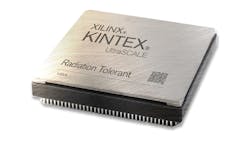Xilinx is platinum winner for 20-nanometer radiation-tolerant XQRKU060 Kintex UltraScale space-grade FPGA
NASHUA, N.H. – Military & Aerospace Electronics and Intelligent Aerospace have recognized Xilinx Inc. in San Jose, Calif., as a platinum-level winner in the publications' 2020 Innovators Awards for the company's 20-nanometer radiation-tolerant XQRKU060 Kintex UltraScale field-programmable gate array (FPGA).
This FPGA enables spacecraft designers to get hundreds of gigabits per second of processing capacity in orbit to enable seamless connectivity aboard broadband satellites.
The XQRKU060 FPGA enables designers of high-throughput and high-bandwidth satellites to process data on board with a 10X Increase in digital signal processing (DSP) capability over the prior-generations Xilinx Space FPGA to handle the task of processing raw sensor information and render usable images.
With an explosion in data and the need for low latency and high bandwidth for applications like video on demand and real-time traffic navigation, today's challenge is how to get hundreds of gigabits per second of processing capacity into orbit that enables seamless connectivity.
These challenges create a need for technology on-board to solve the bottlenecks issues. For the space industry to advance, it cannot lag in the usage of cutting-edge technology nodes. Adopting the latest innovations can enable the processing of data in space rather than ground. Architectures need to be more flexible and adapt to the constantly evolving demands of new algorithms and standards.
Xilinx’s 20-nanometer Radiation Tolerant Kintex UltraScale (XQRKU060) FPGA can enable the designers of high-throughput and high-bandwidth satellites to process data on board with a 10X Increase in DSP compute, compared to prior generation Xilinx Space FPGA.
This offers 400 gigabits per second aggregate bandwidth with the 32 SERDES running at 12.5 gigabits per second per lane. The XQRKU060 provides true unlimited on-orbit reconfigurability and a machine learning ecosystem for high-performance edge inference in space.Often, the task of processing raw sensor information is in-depth and requires signal-processing-intensive techniques such as non-uniformity correction, decimation, equalization, pulse compression, beamforming, and a variety of others. The task of then rendering usable images can include additional tasks such as rotation, back-projection, and ortho-rectification. Not all these tasks have traditionally been possible on-orbit, but the XQRKU060 now opens the door to making this possible.
The architecture for XQRKU060 compares to ASICs that are used traditionally in a space environment. However, due to the fixed functions of application-specific integrated circuits (ASICs), changes in orbit are not possible. SRAM based FPGAs offer on-orbit reconfiguration that changes algorithms on the fly (if new standards are available), bug fixes post-launch, or change functionality by reprogramming the part with a new configuration bit file. This allows a lifetime extension for satellites.
In the XQRKU060, 2760 of its DSPs (with 27x18 multipliers) provide an extensive amount of horsepower for data. Sensor data that is generated needs to reduce with lossless compressions – which allows a speedup compared to an SW implementation, its possible due to the DSP rich architecture.
The XQRKU060 can achieve 400 gigabits per second of aggregate bandwidth with 32 high-speed links running at 12.5 gigabits per second, with BRAM blocks to support low power m 4088796178odes without the need to reprogram. From a radiation perspective, XQRKU060 provides a total ionizing dose of 100 kilorads, with SEL immunity of more than 80MeV that meets worst-case GEO requirements.
It is designed in a spaceworthy ceramic package with columns attached in a 40-by-40-millimeter package, making it suitable for handling vibrations during the launch of satellites, thus providing a high level of functionality at these environmental conditions.
The XQRKU060 also brings high-performance machine learning (ML) to space for the first time. A diverse portfolio of ML development tools supporting industry-standard frameworks, including TensorFlow and PyTorch, enabling neural network inference acceleration for real-time on-board processing in space with a complete “process and analyze” solution.
The XQRKU060’s dense, power-efficient compute with scalable precision and large on-chip memory provides 5.7 teraoperations per second (TOPs) of peak INT8 performance optimized for deep learning, a nearly 25X increase compared to the prior generation.
For more information contact Xilinx online at www.xilinx.com.
